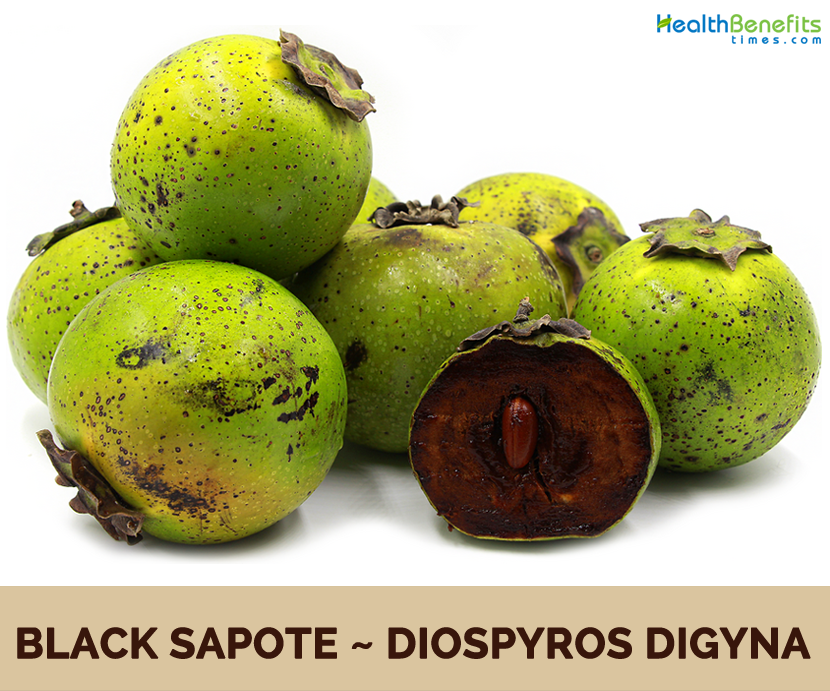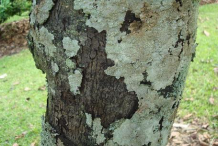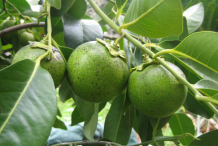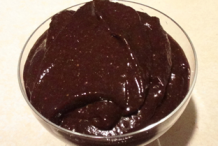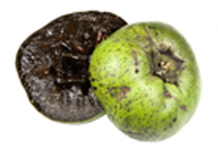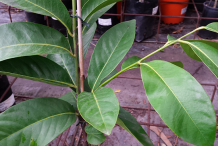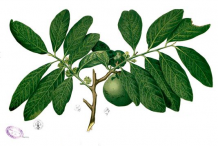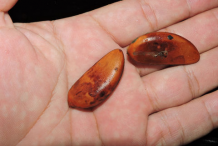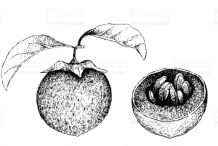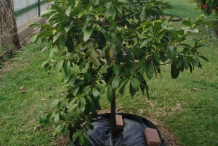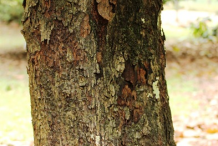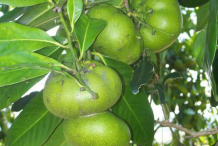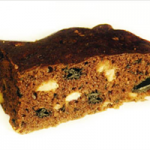Plant Description
Black Sapote is a handsome, broad-topped, slow-growing, perennial evergreen tree that grows up to 80 ft. (25 m) in height with trunk diameter of up to 30 in (75 cm) with a furrowed trunk and black bark. The trees can grow on a range of soil types but thrives on moist sandy loam, on well-drained sand or calcareous soil or oolitic limestone with very little top-soil. The tree grows fairly slowly for the first 3–4 years, perhaps just 30 centimeters per year for the first couple of years. Later it grows much more rapidly. Trees should be spaced 8-10m apart. Leaves are evergreen, alternate, elliptic-oblong to oblong-lanceolate, tapered at both ends or rounded at the base and bluntly acute at the apex, are leathery, glossy, 4 to 12 in (10-30 cm) long.
Flower & Fruit
Black sapote is usually dioecious, meaning that some trees produce only male flowers and no fruit and other trees produce female or bisexual flowers and fruit. Some trees may produce both male and female (or bisexual) flowers on the same tree. The flowers, borne singly or in groups of 3 to 7 in the leaf axils, are tubular, lobed, white, 3/8 to 5/8 in (1-1.6 cm) wide, with persistent green calyx. Fruit are tomato-like and measure 5–10 cm (2.0–3.9 in) in diameter, with an inedible skin that bright-green and shiny at first turning to dull olive-green to muddy-green when ripe. The pulp is white in immature fruit and turns very dark-brown to almost black, soft and somewhat sweetish in flavor when ripe. In the center, there may be 1 to 10 flat, smooth, brown seeds, that are 3/4 to 1 in (2-2.5 cm) long, but the fruits are often seedless.
History
Black Sapotes are native to the southern region of Mexico and can be found growing on the east coast in Jalisco and can be found all the way to the western coast in Yucatan. Fruit was supposed to have come to Mexico from Spain in the late 17th century and then to the Philippines in the late 18th century. The fruit can now be found in Hawaii, Cuba, and Puerto Rico and on the small island of Mauritius off the coast of Africa. Black Sapote trees can be grown in the United States, in Florida. Black Sapote doesn’t grow well in California, mostly because the temperatures are too low. The tropical winter weather is ideal for the Black Sapote; as a result it is one of the few fruits available during the winter months in sub-tropical and tropical regions.
Health benefits of Black Sapote
Black sapote also called as a desert fruit plays a vital role to benefit overall health due the fiber, vitamin and potassium content. One cup of black sapote provides 142 calories, 2.6 g protein, 0.8 g fat, 34 g carbohydrate, 360 mg potassium, 22 mg Vitamin C and 420 IU Vitamin A. Listed below are few of the popular health benefits of Black sapote
1. Strengthen Immune System
Black sapote consists of copious amounts of vitamin C which help the body in fighting harmful foreign toxins and also helps in keeping the body protected from potential diseases. Additionally, it enhances body metabolism.
2. Kidney Health
Potassium found abundantly in the black sapote is extremely beneficial for increasing the stimulation of kidneys. Also, it prevents stones from developing the kidneys. High content of other minerals and antioxidants recover the overall functioning of the kidneys.
3. Weight Loss
Black Sapote fruit consists of ample amount of carotenoids and catechins, which work to release the fat and convert it into energy. It is also low in fat and help delay on hunger. Complex carbohydrates give a long-term satiety due to it takes longer time to digest. Hence, it is good for a weight loss treatment.
4. Improve Digestion
The fruit consists of wonderful amount of dietary fiber. Thus, it helps to improve the digestion by enhancing a fast digestion and absorbing only important nutrients. It avoids the body to gain unnecessary weight. Additionally, it maintains peristaltic movement and improves the work of intestine.
5. Ensures Eye Health
Vitamin A has long been credited with the development of new cells and in overall healthy cell growth. It is also considered to be very beneficial for the health of sight. Being enriched with vitamin A, black sapote is a great fruit that provides a natural supply of plentiful vitamin A. Black sapote is the chief source of vitamin A thus ensuring eye health and improved vision.
6. Control Blood Pressure
Black sapote fruit helps to preserves the blood pressure. It decreases the high blood stress as well as high blood pressure. You could have this fruit daily to control the high blood pressure. Its potassium as well as iron assistance to maintain the blood stress. You can have this fruit along with your blood pressure control medicine.
7. Anti-Aging
The capability of an anti-oxidant makes this fruit also works as an anti-aging. It makes the body look younger and relief the stresses mind. The anti-oxidant capability also can give protection from the disease related with early aging. It stimulates the collagen to bring a healthy skin texture.
8. Bone Strength
Black sapote fruit consists of calcium, phosphorus, iron, potassium. These minerals help to strength the bone. This may avoid fracture on the bone and add the mass density of the bone. Thus, it is a good way to improve a healthy bone.
9. Balance Electrolyte
As mentioned before Black Sapote is a good source of potassium. Human being requires 100 mg of potassium daily and Black Sapote consists of 350 mg of potassium. This property of the fruit builds muscles, maintains the fluid-electrolyte balance and heart’s electrical activity. It helps to control blood pressure, kidney problems as well as other issues.
10. Hormone Balancing
Due to the presence of many nutrients, black sapote helps keep the nerves calm and lower down the level of stress and depression. Because elevated stress mostly causes hormone imbalance, consumption of black sapote can prove beneficial in hormone regulation.
11. Prevent Constipation
Black sapote has the capability to improve digestion also can help to prevent constipation. It works as a laxative and decrease the acid inside the stomach. Therefore, it helps to reduce nausea feeling and controlling the stomach to avoid heartburn.
Traditional uses and benefits of Black Sapote
- Crushed bark and leaves have been applied as a blistering poultice in the Philippines.
- Leaf decoction was used as an astringent and was taken internally as a febrifuge in Yucatan.
- Various preparations were used against leprosy, ringworm and itching skin conditions.
Culinary Uses
- Fruits are best picked and eaten when fully ripe, the pulp becomes soft and pudding like at this stage.
- Pulp is eaten fresh with lemon or orange juice, or in pastry creams or used in desserts and beverages.
- Popular desserts include Black sapote mousse, cakes, cheese cakes, bavarois, custards, stuffing for pies and pastry, black sapote torte, black sapote topping (pulp, icing sugar, rum or brandy) or serving it as a sauce with papaya and ice cream.
- One popular dessert is “Black Sapote Fairy Queen Boat” which includes black sapote topping, ice-cream, mixed fruit and with sherry or port.
- Pulp is served as dessert with a little milk or orange juice poured over it in Philippines.
- Pulp can be blended, filtered and mixed with orange juice or brandy, and then served with or without whipped cream or the pulp is mixed with wine, cinnamon and sugar and serve as dessert in Mexico.
- Pulp can be fermented to made a brandy-like liqueur as in Central America or blended with pineapple juice to give a foamy, delicious beverage.
- Immature fruits can also be eaten as vegetable when boiled.
How to Consume Black Sapote
Black sapote can be consumed in numerous ways. Therefore, we can gain the health benefit of black sapote easily. The lists below are some ways to consume black sapote.
1. Direct Consumed
Fastest and easiest way to consume it by directly eats the ripe fruit. Since it tastes like a chocolate pudding, thus many peoples prefer to consume it without adding anything. Make sure not to consume the unripe fruit, since it is bitter and irritating.
2. Ice Cream
It is the good news that black sapote can be produced as an ice cream. Hence, it is a fun way to get the health benefits of black sapote.
3. Juice
Another alternative to consume black sapote is by blend it as a juice. For additional flavor, you can add some milk.
4. Dessert
The most common way to consume black sapote is by making it as a dessert. There are several dessert recipes which contain black sapote as its ingredients namely pudding, cakes, mousse or smoothie.
Other Facts
- Unripe fruits are very astringent and are sometimes used as fish poison.
- Wood is yellowish to deep-yellow with black markings near the heart of old trunks; compact and suitable for cabinetwork but little used.
Side Effects of Black Sapote
Black sapote, like any other fruit, also has side effects. Thus, people shall be aware on these side effects before consuming the fruit. Below are some side effects of black sapote:
1. Allergic
Some people who tend to get allergy of something shall be careful when consuming this fruit. Since it can bring allergic reactions such as rash, itchiness or even nausea. In case you feel those signs after consuming the fruit, it is better to stop consuming.
2. Interfere medicine
Consuming the fruit might affect the medicine. Thus, people under medical treatment shall avoid consuming this fruit. Since it can reduce the effectiveness of the medicine.
3. Increase sugar level
Fruit is having a sweet taste and a complex carbohydrate. Therefore, there is a possibility that it can increase the sugar level inside the blood. Therefore, diabetic patient better avoid consuming this fruit.
Black Sapote Recipes
Black Sapote Mousse
Ingredients
- Black sapote pulp – 1 cup
- Vanilla flavoring extract – 1 teaspoon
- Powdered sugar – 3 tablespoons
- Whipped cream – 1/2 cup
Directions
- Blend black sapote pulp, sugar, and vanilla extract together.
- Fold in whipped cream and serve chill, do not freeze.
Black Sapote Cake
Ingredients
- Black sapote pulp – 2 cups
- Vanilla extract – 1 teaspoon
- Margarine – 1/2 cup
- Cinnamon – 2 teaspoons
- Honey – 1 cup
- Eggs – 3
- Baking soda -1/2 teaspoon
- Baking powder – 1/4 teaspoon
- All-purpose flour – 2 cups
Directions
- Mix margarine and honey gradually. Add egg yolks and black sapote pulp.
- Combine the dry ingredients. In a separate bowl, beat the egg whites and add vanilla extract.
- Fold in the mixture to the margarine mix. Preheat, the oven to 350 degrees F. Pour the mix into the baking pan and bake for 45 minutes.
Black Sapote Bread
Ingredients
- 1 ripe black sapote
- ½ stick of butter, melted (equal to ½ cup)
- 1 egg, beaten
- 2 teaspoons vanilla extract
- 1 teaspoon baking soda
- pinch of salt
- 1½ cups of all-purpose flour
- ¾ cup sugar
Directions
- Cut the black sapote in half. Using a spoon, scoop out the soft fruit into a medium sized bowl and remove the seeds.
- Add the melted butter to the black sapote and mash together with a fork.
- Next, stir in the sugar, vanilla, and egg.
- In a separate bowl, mix together the flour, baking soda, and salt. Then pour it into the bowl with the black sapote and mix together with a fork until it’s well blended.
- Pour into a greased bread pan and bake at 350 degrees for one hour. (You can use one regular sized bread pan or two mini bread pans.)
- Let it cool, then enjoy!
References:
https://www.itis.gov/servlet/SingleRpt/SingleRpt?search_topic=TSN&search_value=505968#null
https://davesgarden.com/guides/pf/go/55610/
http://www.hear.org/pier/species/diospyros_digyna.htm
https://npgsweb.ars-grin.gov/gringlobal/taxonomydetail.aspx?id=14280
https://www.pfaf.org/user/Plant.aspx?LatinName=Diospyros+digyna
https://plants.usda.gov/core/profile?symbol=DIDI15&mapType=nativity
https://hort.purdue.edu/newcrop/morton/black_sapote.html
https://www.cabi.org/isc/datasheet/19552
https://www.darwin.nt.gov.au/sites/default/files/publications/attachments/black_sapote.pdf
Comments
| Black Sapote Quick Facts | |
|---|---|
| Name: | Black Sapote |
| Scientific Name: | Diospyros digyna |
| Origin | South America |
| Colors | Bright green to yellowish-green and shiny at first, turning to dull olive-green to muddy-green as mature |
| Shapes | Tomato-like and measure 5–10 cm (2.0–3.9 in) in diameter, with an inedible skin |
| Flesh colors | White in immature fruit and turns very dark-brown to almost black as they mature |
| Taste | Sweet like custard, nut-like flavor |
| Health benefits | Strengthen Immune System, Kidney Health, Weight Loss, Improve Digestion, Ensures Eye Health, Control Blood Pressure, Anti-Aging, Bone Strength, Balance Electrolyte, Hormone Balancing, Prevent Constipation |
| Name | Black Sapote |
|---|---|
| Scientific Name | Diospyros digyna |
| Native | South America |
| Common Names | Axle Grease Plant, Black Apple, Black Persimmon, Black Sapote, Chocolate Persimmon, Chocolate Pudding Fruit, Chocolate Pudding Tree, Sapote Negro, Axle Grease Plant, zapote prieto, Caca-poule, Ebano, Guayabote, Mueque, Tauch, Zapote negro, barbaquois, ebenholzbaum |
| Name in Other Languages | Antilles : Barbacoa, Barbaquois, Caca Poule Chinese : Hei shi Danish : Sort Ibenholt English: Black persimmon, Black sapote, Chocolate pudding fruit, Axle Grease Plant, black apple, Chocolate Pudding Tree Filipino: sapote negro French : Barbaquois, Ébčnier Des Antilles, Kaki Noir, Sapote Noire, Sapotier, Barbaquois, Barbacoa, Caca poule, German: Ebenholzbaum, Schwarze Sapote Indonesia : Sawo Hitam Japanese: Diosupirosu Nigura Hawaii: Black persimmon Mexico : Guayabota, Zapote Prieto, Tliltzapotl Philippines : Zapoté Negro Portuguese : Ébano Das Antilhas Spanish : Ebano, Ébeno Agrio, Guayabota, Matasano De Mico, Sapote, Sapote Negro, Zapote, Zapote De Mico, Zapote Negro, Zapote Prieto Swedish: Svart sapote Taiwan: Hei Shi |
| Plant Growth Habit | Handsome, broad-topped, slow-growing, perennial evergreen tree |
| Soil | Thrives on moist sandy loam, on well-drained sand or calcareous soil or oolitic limestone with very little top-soil |
| Plant Size | Grow up to 80 ft. (25 m) in height with trunk diameter of up to 30 in (75 cm) |
| Bark | Black |
| Leaf | Evergreen, alternate leaves, elliptic-oblong to oblong-lanceolate, tapered at both ends or rounded at the base and bluntly acute at the apex, are leathery, glossy, 4 to 12 in (10-30 cm) long |
| Flower | Borne singly or in groups of 3 to 7 in the leaf axils, are tubular, lobed, white, 3/8 to 5/8 in (1-1.6 cm) wide |
| Fruit Shape & Size | Tomato-like and measure 5–10 cm (2.0–3.9 in) in diameter, with an inedible skin |
| Fruit Color | Bright green to yellowish-green turning to dull olive-green to muddy-green as mature |
| Fruit skin | Thin and soft firm rind |
| Flesh color | White in immature fruit and turns very dark-brown to almost black as they mature |
| Seed | 1 to 10 flat, smooth, brown seeds, 3/4 to 1 in (2-2.5 cm) long, but the fruits are often seedless |
| Flavor/Aroma | Somewhat sweet and rich in flavor |
| Taste | Sweet like custard, nut-like flavor |
| Plant Parts Used | Bark, leaves, fruit |
| Propagation | Seeds, grafting or budding |
| Health Benefits |
|


